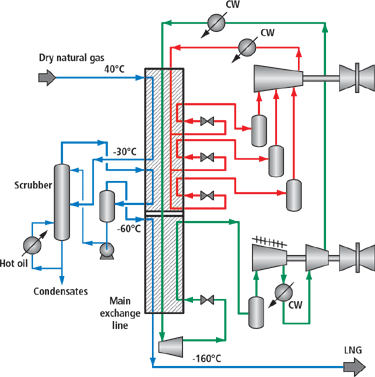 Technology from Europe: Technology from Europe:
France/Belgium
New gas liquefaction process provides increased capacity at reduced cost
Pierre Boutelant, Senior Advisor, LNG, Axens, Rueil Malmaison, France
French firm Axens and its parent company, IFP, has developed a process for liquefaction of natural gas that achieves the best usage of large gas turbines and plate-fin heat exchangers. Compared to existing technologies, this process provides increased capacity and a reduced investment cost, while remaining simple and reliable. Very large capacities (up to 8 million t/year) can be achieved in one train at a very low LNG unit cost and with minimal space required.
The Liquefin process operates according to the typical flow scheme presented in the diagram (this page) on the following. The pre-refrigeration of gas is achieved by using a mixed refrigerant instead of propane. In this process, the pre-refrigeration cycle operates at a much lower temperature than when propane is used, and the temperature is decreased down to about – 60°C ( – 75°F). At this temperature, the cryogenic mixed refrigerant can be completely condensed, so that the quantity of this refrigerant is substantially reduced.
 |
In the Liquefin general scheme, the pre-refrigeration cycle operates at a much lower temperature than when propane is used.
|
|
The molar ratio between the cryogenic mixed refrigerant and LNG can, in some cases, be lower than 1:1. The overall, required power is reduced, as a good part of the energy necessary to condense the cryogenic mixed refrigerant is shifted from the cryogenic cycle to the pre-refrigeration cycle. Moreover, this shifting of energy leads to a better distribution of the necessary heat exchange area. The same number of cores in parallel can be used all along the line between the ambient and cryogenic temperatures.
In the Liquefin process, both mixed refrigerants are used in the same way as pure components. The mixed refrigerant is condensed and vaporized at different pressure levels in each section, without any phase separation or fractionation. This way, the exchange line can be kept very simple and compact.
A significant advantage of this new scheme is the opportunity to adjust the power balance between the two cycles. Thus, it is possible to directly use the full power provided by two identical gas turbines, without any transfer of power from one cycle to the other.
An LNG production between 3 million and 8 million t/year can be achieved on one single train, at quite attractive conditions as regards CAPEX and OPEX. 
|

 Technology from Europe:
Technology from Europe:

